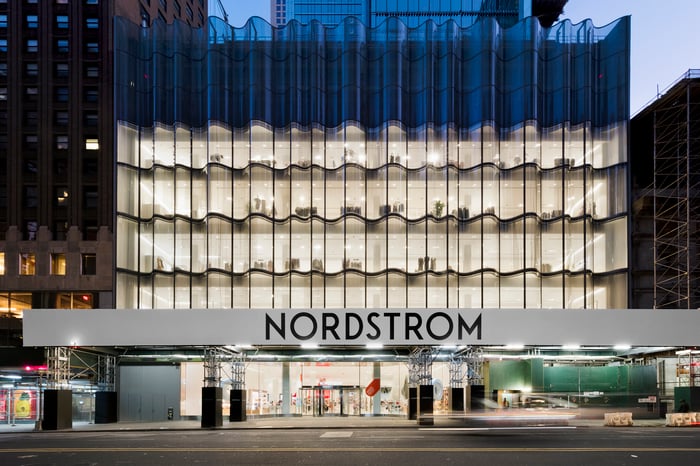On Tuesday afternoon, Nordstrom (JWN -0.33%) reported that sales jumped 44% year over year last quarter. Meanwhile, the iconic retailer significantly reduced its net loss compared to the prior-year period, when the COVID-19 pandemic crushed its sales and profitability.
Nevertheless, Nordstrom stock sank 6% on Wednesday, as the results didn't meet investors' elevated expectations. With demand for dressy clothing likely to make a strong recovery over the next few quarters, this setback for Nordstrom shares could be a good buying opportunity.
Nordstrom year-to-date stock performance. Data by YCharts.
Slower progress than other department stores
Nordstrom's sales trajectory improved by 7 percentage points sequentially last quarter, with good progress in both its full-line and off-price segments. Digital sales grew 23% year over year and 28% compared to the first quarter of fiscal 2019. Still, total sales remained 13% below 2019 levels for both the Nordstrom and the Nordstrom Rack brands, as in-store sales volumes haven't gotten close to pre-pandemic levels yet.
Lower sales -- combined with gross margin pressure related to the company's efforts to clear out stale inventory -- caused Nordstrom's operating margin to shrink by 5.2 percentage points relative to Q1 2019. As a result, the company recorded an $85 million quarterly operating loss.
Nordstrom's sales actually exceeded its plans last quarter, according to management. Additionally, the company reaffirmed its full-year sales and earnings guidance.

Image source: Nordstrom.
Clearly, investors were hoping for more. After all, many department store chains have reported stronger sales and earnings recoveries. For example, Kohl's (KSS 0.30%) said last week that sales rebounded to nearly $3.7 billion last quarter: down just 4% from the first quarter of fiscal 2019. Moreover, Kohl's increased its gross margin compared to two years ago, allowing it to post significantly higher earnings than it did in Q1 2019.
A gradual recovery shouldn't be surprising
While investors may have been disappointed by Nordstrom's first-quarter performance, they shouldn't have been surprised. The retailer faces two key headwinds compared to fellow department store operators like Kohl's.
First, Nordstrom isn't a big player in the merchandise categories that are recovering fastest. It reported strong growth in home and children's apparel last quarter, but those categories accounted for just 7% of Nordstrom's sales last year. By contrast, Kohl's got 23% of its sales from the home department and another 14% in children's apparel during fiscal 2020, giving it a big leg up in the near term.
Even within men's and women's apparel and footwear, Nordstrom has traditionally focused on "dressy" items, whereas Kohl's primarily sells casual items. Here, too, Nordstrom's merchandise mix will remain a liability until workers return to offices and events like weddings and galas resume.

Image source: Nordstrom.
Second, Nordstrom gets the bulk of its revenue from the West Coast and the Northeast. State and local governments tended to impose greater retail restrictions in those regions. Sure enough, revenue is recovering at a slower pace in those markets than in the Sun Belt, where Nordstrom has a smaller presence.
No cause for concern
At the beginning of last quarter, COVID-19 case counts remained quite high in the U.S., and few people were fully vaccinated. Since then, case counts have fallen dramatically, largely thanks to the coronavirus vaccine rollout. (Today, 62% of U.S. adults have received at least one vaccine dose.) This is allowing even the most cautious state and local governments to move toward fully reopening their economies.
As a result, demand for dressy apparel and other key Nordstrom merchandise categories will probably bounce back in a meaningful way starting this summer. Despite its sluggish Q1 sales performance, Nordstrom should be able to rebuild sales to 2019 levels or better within a couple of years. That could boost earnings per share to between $4 and $5, thanks to cost cuts implemented last year.
Nordstrom has a long way to go to complete its post-pandemic turnaround. But while the process will take longer than at its peers focused on casual apparel and home goods -- like Kohl's -- Nordstrom is likely to meet its long-term financial targets by 2023 or so. If it succeeds, the resulting surge in EPS could send Nordstrom stock flying higher.






